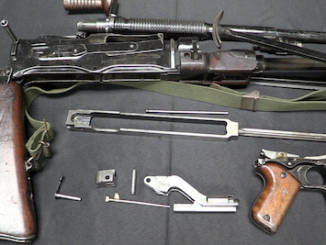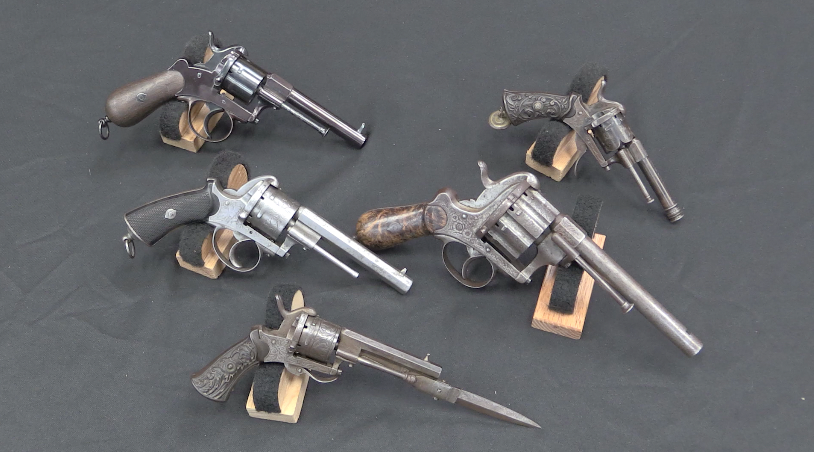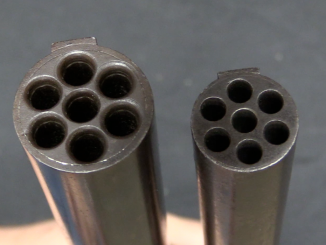This pistol is for sale as part of Lot 280 at Rock Island’s Regional auction on June 20th.
Emile and Leon Nagant set up their manufacturing company in Liege, Belgium in 1859, and it would become one of the most prominent in the city. The brothers worked with a variety of other patent holders, including striking a deal with the Remington company. This would lead to Nagant production of rolling block rifles for the Vatican guards, and also the model 1877 Gendarmerie pistols.
Adopted as standard ams for the Belgian Gendarmerie and not replaced until the introduction of the Browning Model 1899, these were double-barreled rolling block action pistols chambered for the Belgian 9.4mm revolver cartridge. They have a single trigger and two hammers, and the trigger will fire either barrel if only one is cocked, or the right and then left barrel if both hammers are cocked (the trigger must be released to reset between barrels). A total of 2000 were made, and their Gendarmerie usage is indicated by the “W” stamp on the buttcap.




OMG! Want!
How is it I’d never even heard of this before Forgotten Weapons? Oh… Right… Forgotten!
Thanks, again.
I would presume the long grip makes the pistol do double-duty as a club or cosh, either held correctly or reversed after shooting. The lanyard ring fixture belies this, but I would suspect there was some head-bashing done with this model. Unless someone turns up an official Gendarmerie truncheon or baton or long club of separate issue …
Assuming you don’t break your gun first, okay. Batons were generally issued for more “civilized” approaches without requiring the subject getting shot first. But gendarmes are more or less military cops, right?
No. They are cops.
To be more precise, although a part of the Belgian Military the Gendarmerie was a police force organized at a national level.
They were merged with the national police some years ago.
historypistols.ru/blog has a very informative page for this pistol. Single trigger mechanism looks magnificient.
They probably had sabers and the flat of a saber is a useful motivator…
This pistol was meant to replace a pair of percussion pistols carried in saddle holsters (yes 1 double shot pistol for 2 single shot pistols).
This double barrel design was also made in shotgun form by the Nagant brothers.
They patented a series of improvements on the rolling block action, mostly extractors and underlevers to cock and open the action in a single motion.
Awesome! Thanks for the great info!
Cannot comment on Belgium or Austria, where the gendarmerie was merged with the national police, but in France the Gendarmerie are both police–including the GIGN counter-terror squad–and a branch of the armed forces, albeit under the purview of the Ministry of the Interior. Neighboring Spain has a Policia Nacional, including the riot squad, and also the Guardia Civil, which while ostensibly a police organization has traditionally been housed in barracks and so on… A parapolice/ police-quasi-military organization. The carabineros de Chile, similarly, are a branch of the armed forces.
Recall that in WWI, Belgium was possessed of a “Garde Civique” wearing bowler hats and armed with Comblain rifles… The Wilhelmine Germans had the Landwehr and the Landsturm, but complained mightily that the sheer effrontery of the Belgians attempting to defend their national sovereignty and treat obligations (the “mere scrap of paper”) would oblige them to shoot civilians as hostages, burn down medieval manuscript libraries und so weiter… While complaining about the British propagandists simultaneously wreaking havoc with a naval blockade and publicizing or exaggerating said German responses to outrageous Belgian behavior…
One wonders how many of these fascinating pistols actually survived the years…?
Ian…. What great timing with this video. I recently acquired one of these fine pistols, #1754, just a month ago. The one I obtained does not have any maker markings visible any longer because either when produced or sometime thereafter, it was heavily engraved with scroll marks. It doews have some Belgian Proof Marks showing that it was proofed for BP. Trying to find ammunition is impossible but I did acquire a lot of information on the cartridge. I have a lot of information on the gun I purchased and also on making my own cases from .41 Rem Mag cases and casting bullets. It is in a PDF file and if you are interested, send me an e-mail and I’d be glad to share it with you. I had some range time with it today and it was a blast to shoot! Fired 26 rounds just to fire form some cases. Absolutely zero issues!
Subcompact Howda.
Hahahaha! Right on, sir!
It says a great deal about the air of authority Belgian society vested in its police at that time, that they were considered adequately armed with a two-shot “mini-howdah” pistol, chambering a standard revolver cartridge.
I suspect the IA drill was to shout “HALT!” in an authoritative voice, and if that didn’t work, fire one shot up in the air. Criminal turns to see double-barrelled pistol leveled at him, and is aware the next shot won’t be in the air.
It’s worth noting that the replacement, the 1899 model revolver, arrived just as the “anarchist terror” was becoming serious in France and Belgium both, five years after the assassination of French President Marie François Sadi-Carnot in Lyon, France (25 June 1894).
In fact, the first “political” assassination in Belgium was the murder of Charles I, Count of Flanders in 1127, and there wouldn’t be another until that of Julian LeHaut, leader of the Belgian Communist Party, in 1950. Belgium just doesn’t seem to “roll” that way.
Still, considering that revolver manufacture was a major industry in Belgium going back to pepperbox days, it seems odd that the police would be armed with “just” a double-barreled pistol.
cheers
eon